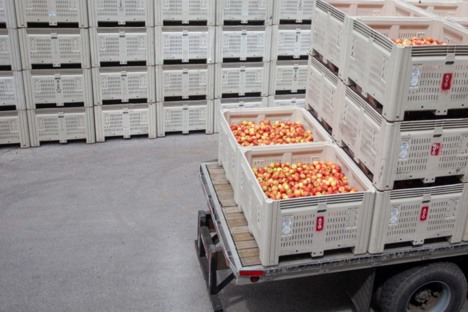The last USApple Harvest Wrap Up webinar revealed some interesting trends from the national harvest of apples this year. In August there was a United States Department of Agriculture (USDA) estimated the all U.S. apple production for the 2023/2024 season to be at 236 million bushels. Following it up with the USApple Outlook Conference in Chicago and the revised number of at 256 million bushels. (While the USDA numbers included seven of the leading apple-producing states association’s figure included the production figures of every state that produces apples.)
The breakdown by state is:
Washington: The biggest growing area in the country was predicted to produce 160 million bushels during 2023-2024.
Image: US Apple Association
Michigan:This Midwestern state was predicted to produce 32 million bushels.
New York: 28 million bushels of apple were anticipated to be planted within New York state this season.
Pennsylvania, California, Virginia and Oregon were predicted to contribute 20-25 million bushels. The remaining states contributed 14 million bushels in the 2023-2024 seasons.
Fresh vs. processing updates
In a monthly study of storage data for November, the monthly reports showed that there was 190 million bushels stored in the storage facility–140 million of which were fresh, and 51 million for processing. “The most recent time that we had the total amount of holdings the size of this was during November 2014-2015 season. Storages in November during that time included 188 million bushels” claimed Christopher Gerlach, director of the industry’s analytics at USApple.
In contrast, 2014-2015 saw an increase in fresh produce, while processing stocks are significantly larger than total of 2014-2015 – 51 million bushels, compared to. 44 million in the previous season. “I suspect a significant portion of this is due to the economic downturn this year, given the harvest this year as well as the processing capacity of processors to replenish their bank accounts with the apples from last year’s harvest,” stated Gerlach.
Washington has reported 152 million barrels stored in the storage facility, more than 40% higher than the November totals and equal to about 42 million bushels of year-overyear (YOY) increase. “That represents approximately 90 percent of increase in the national economy. The YOY growth in Washington was similar to adding an extra Michigan or Pennsylvania season of production. This is a massive amount of bushels more to be brought to market” Gerlach noted.
 Photo: US Apple Association
Photo: US Apple Association
New York holdings up
The year ending in New York, 15 million bush were stored, that’s about 44 percent increase in YOY, a number that was the major reason for the remaining overall expansion.
Michigan has reported that it had 12 million bushels of storage the state, which represents a 6 percent decline in the YOY figures. “It is around 1 million bushels less than in the past, however they’re higher than the five-year average,” says Gerlach.
All in all these states make up approximately 94 percent of remaining storage.
As a matter of fact, Honeycrisp swapped with Gala this year, making it the most popular variety in storage, having 30 million bushels — a 62 % YOY growth. Galas were just a bit lower having 29 million bushels of storage at the end of November. This was which is a rise of 12 percent.
Red Delicious had 26 million bushels that is rise of 44 percent; Granny Smith has 23 million bushels which is an increase of 61 percent and Fujis rose 17 percent.
The other varieties that were not among those listed in the top five included 13 million bushels which is 16.6% lower. However, some of this is because of Envy being taken out of the category and being reintroduced as a separate line selection. (Should Envy have stayed in the category, its totals of the crop could have been reported as 10% YOY growth.)
When Envy managed variety, with 4.2 million bushels has earned its position and displaced Braeburn as the best of the list, in the category of managed varieties, Cosmic Crisp continues to expand by accumulating 9.5 million bushels of holdings, which is up 41 percent.
 For further information:
For further information:
Christopher Gerlach
US Apple Association
Tel: +1 (703) 442-8850
cgerlach@usapple.org
www.usapple.org
